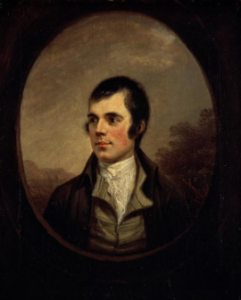Robbie Burns Timeline

1746
The end of the final Scottish war (the Jacobite uprising) against the English. The wars affects and loss of family land and wealth causes William Burnes to migrate. He relocates from the north east of Scotland to Edinburgh and eventually to Alloway.
![]()

1759; January 25th: born in Alloway.
His birthday has then become officially known as” Robbie Burns Day.” The cottage where in which he was born is now a museum.
January 26th: Robbie is baptized.
![]()
1765: Begins school education.
![]()
1766:The Burns family relocates to a new farm lease at Mt Oliphant.
1773: Robbie composes “Handsome Nell.”

1775: The American revolution begins
1777: Burns family relocates to Lochlea. Robbie visits Kirkoswald over the summer.
1781: Robbie moves to Irivine to study flax refinement (linen making). At the time, Irvine was a significant global port. There he met and enjoyed company of sailors, soldiers, new world colonies emigrants and traders. He also enjoyed company with Richard Brown who encouraged Robbie to focus on his poetry.
The flax factory is burnt down in an accident and Burns returns in ill-health to the farm.
1783:Robbie and his brother Gilbert rent a farm in Mossigel. Robbie wins a three pound award for his flaxseed and begins to write “Commonplace Book.”
1784: Robbie’s father William dies. Robbie becomes the head of the family and has to look after his six other younger brother and sisters.
Known Lover: Nelly Kilpatrick
Known lover: “Dear Bess”
Known lover: Elizabeth Paton
Known lover: Robbie first meets Jean Armour in the town of Mauchlin. Jean later becomes a lifelong lover and bore him nine children. Jean also becomes the subject of multiple poems and songs. Jean is considered “the true love of his life”
1785: A Baby Burns! Elizabeth Paton a local farm girl bears a baby girl Elizabeth.
1786: Known Lover: Meg Cameron a barmaid.
Known Lover: “Highland Mary “Campbell. It is said that they declared their love for each other by swapping bibles on the River Fail.
July 31st releases “The Kilmarnock Edition” which is published to wide acclaim and helps solidify Robbie’s career as a poet. Contains “To a Mouse” and “The Holy Fair.”
Robbie is offered a job as a West Indies plantation book keeper and begins plans to emigrate to Jamaica with Mary. However Mary’s untimely death and the success of his book enables him to repay some business and familial debts and convinces him to stay in Scotland.
Two more baby Burns! Jean Armour bears twins, Robert and Jean.

1787: Friend and painter Alexander Namsyth completes his famous portrait of Robbie, commissioned as a book-cover.
Robbie tours the highlands with friend William Nicol. Robbie famously etches lines of poems into windows and masonry of which many are still preserved and visible today.
1787: Known Lover: Meets Agnes Mc Lehose the subject of “Ae Fond Kiss.”
Known Lover: Jenny “Clarinda” Clow, who was Agnes’s housemaid in Edinburgh.
Together with James Johnson authors the “Scots Musical Museum” a compendium of 600 Scottish songs including originals by Robbie. In the final print in 1803 Robbie was accredited contributing about 200 original songs.
1788: A Baby Burns: Jean bears two more twin girls. Unfortunately both die of complications within weeks of their birth.
A Baby Burns! Jenny Clow bears a son, Robert.
Robbie moves to Ellisland farm (Dumfreisshire) and finally marries Jean Armour.
1789: Known Lover: Ann Park.
1789: The French Revolution begins
1790: Composes “Tam o’ Shanter” a longer poem about a cheeky local town drunk named Tam whom one day on his way home stumbles across a witches gathering. Has become one of his most well known and quoted works.
1791: Robbie runs out of money from publishing and gets work as a local Customs and Excise (tax) officer.
1795: Due to his continual and vocal support for the French and American Revolutions Robbie is forced to recant his views in public (or lose his job as a Excise officer).
1796: July 21st Robbie Burns dies in Dumfreis from illness.
July 25th A Baby Burns: Jean bears Maxwell Burns, born on the day of Robbie’s funeral.
It was large ceremonial funeral with thousands of folks attending.
1830: The first (of many) official statues of Robert “Robbie” Burns was commissioned. It was on show at the 1859 Crystal Palace world-exhibition, and thanks to private owners made its way to the opposite side of world and now sits in the small dairy town of Camperdown in western Victoria, Australia.
1831: the foundation stone of the Burns Monument in the Edinburgh Carlton Gardens is laid.
Today: globally there are approximately 2,500 registered fan clubs and societies that celebrate his life and his works.


